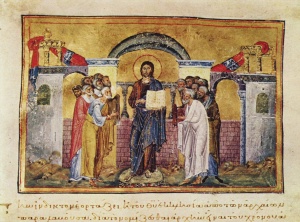Difference between revisions of "Pantocrator"
(add icon;) |
|||
| (3 intermediate revisions by 3 users not shown) | |||
| Line 1: | Line 1: | ||
[[Image:Hagia Sophia Christ.jpg|thumb|175px|Pantocrator]] | [[Image:Hagia Sophia Christ.jpg|thumb|175px|Pantocrator]] | ||
| − | The word '''Pantocrator''' is of Greek origin meaning "ruler of all". Christ Pantocrator is an [[icon]] of [[Christ]] represented full or half-length and full-faced. He holds the book of the [[Gospels]] in his left hand and blesses with his right hand. | + | The word '''''Pantocrator''''' is of Greek origin meaning "ruler of all". '''Christ Pantocrator''' is an [[icon]] of [[Christ]] represented full or half-length and full-faced. He holds the book of the [[Gospels]] in his left hand and blesses with his right hand. |
The icon portrays Christ as the Righteous Judge and the Lover of Mankind, both at the same time. The Gospel is the book by which we are judged, and the blessing proclaims God's loving kindness toward us, showing us that he is giving us his forgiveness. | The icon portrays Christ as the Righteous Judge and the Lover of Mankind, both at the same time. The Gospel is the book by which we are judged, and the blessing proclaims God's loving kindness toward us, showing us that he is giving us his forgiveness. | ||
[[Image:Pantokrator of Sinai.jpg|thumb|100px|left|Pantocrator of Sinai]] | [[Image:Pantokrator of Sinai.jpg|thumb|100px|left|Pantocrator of Sinai]] | ||
| + | [[File:Christ Pantocrator (Menologion of Basil II).jpg|right|thumb|Pantocrator (''Menologion of Basil II, 10th-11th c.'')]] | ||
Although ruler of all, Christ is not pictured with a crown or scepter as other kings of this world. The large open eyes look directly into the soul of the viewer. The high curved forehead shows wisdom. The long slender nose is a look of nobility, the small closed mouth, the silence of contemplation. | Although ruler of all, Christ is not pictured with a crown or scepter as other kings of this world. The large open eyes look directly into the soul of the viewer. The high curved forehead shows wisdom. The long slender nose is a look of nobility, the small closed mouth, the silence of contemplation. | ||
| + | |||
It is the tradition of the [[Church]] to depict "God is with us" by having the a large Pantocrator icon inside of the central dome, or ceiling of the church. | It is the tradition of the [[Church]] to depict "God is with us" by having the a large Pantocrator icon inside of the central dome, or ceiling of the church. | ||
| − | The oldest known Pantocrator icon was written in the sixth century. It was preserved in the monastery of St. Catherine in the Sinai desert. This remote location enabled the image to survive | + | The oldest known Pantocrator icon was written in the sixth century. It was preserved in the monastery of St. Catherine in the Sinai desert. This remote location enabled the image to survive the [[Iconoclasm|iconoclastic]] era in Byzantine history (726-815) when most icons were destroyed. |
[[Category:About Icons]] | [[Category:About Icons]] | ||
| − | [[el:Ο Χριστός Παντοκράτωρ (αγιογραφία)] | + | [[el:Ο Χριστός Παντοκράτωρ (αγιογραφία)]] |
Latest revision as of 23:38, January 15, 2013
The word Pantocrator is of Greek origin meaning "ruler of all". Christ Pantocrator is an icon of Christ represented full or half-length and full-faced. He holds the book of the Gospels in his left hand and blesses with his right hand.
The icon portrays Christ as the Righteous Judge and the Lover of Mankind, both at the same time. The Gospel is the book by which we are judged, and the blessing proclaims God's loving kindness toward us, showing us that he is giving us his forgiveness.
Although ruler of all, Christ is not pictured with a crown or scepter as other kings of this world. The large open eyes look directly into the soul of the viewer. The high curved forehead shows wisdom. The long slender nose is a look of nobility, the small closed mouth, the silence of contemplation.
It is the tradition of the Church to depict "God is with us" by having the a large Pantocrator icon inside of the central dome, or ceiling of the church.
The oldest known Pantocrator icon was written in the sixth century. It was preserved in the monastery of St. Catherine in the Sinai desert. This remote location enabled the image to survive the iconoclastic era in Byzantine history (726-815) when most icons were destroyed.


